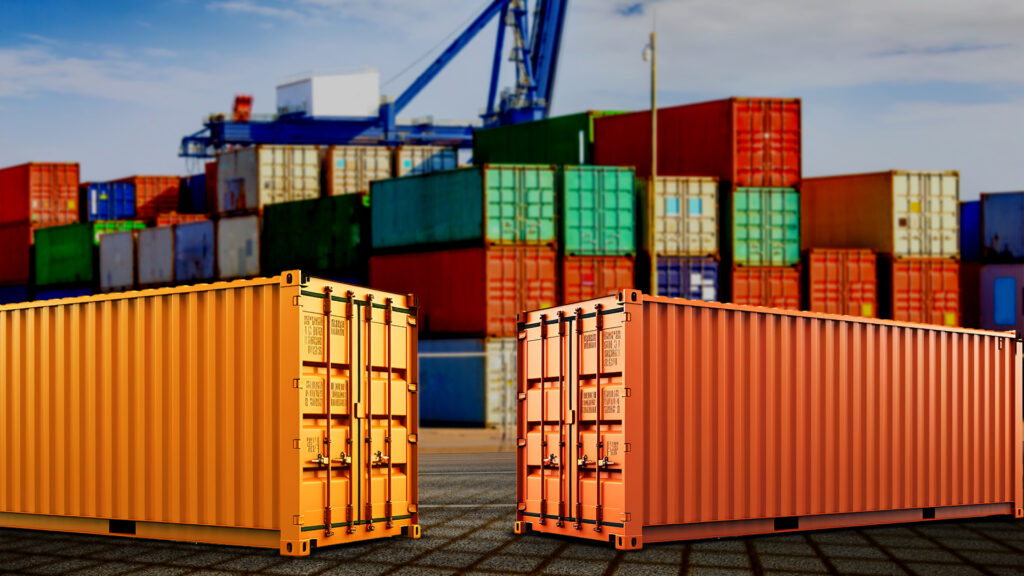Looking to ship products overseas? Wondering what size shipping container you need? You’ll want to understand standard shipping container dimensions so you can optimize cargo space and costs.
The humble shipping container enables over 90% of global trade, carrying everything from cars to computers across oceans. However, these metal boxes come in different sizes to meet diverse cargo needs.
In this guide, we’ll break down the measurements for popular dry and specialty containers. Knowing ISO specifications for 20ft, 40ft, and high cubes will help you select the right container type.
Most Common Standard Shipping Container Sizes
With standardization came a consolidation around a few principal container sizes and types. While there are small variations, most shipping containers you’ll encounter will be one of these common varieties:
20ft ISO Container Dimensions
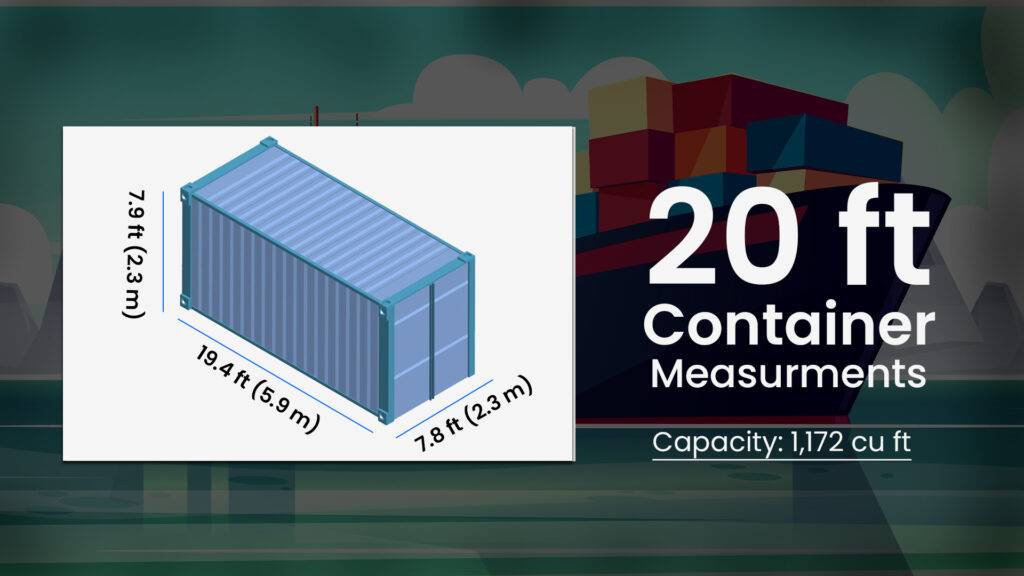
The 20-foot container, or 20-footer, is the smallest standard-sized container available. Externally, it measures 20ft x 8ft. With an internal length of 19.4ft and internal width of 7.8ft, it provides 1,178 cubic feet of cargo capacity. The tare weight is 2,300kg and the maximum payload is 25,000kg. Total cubic capacity is 33.2 m3.
20ft containers are ideal for lighter cargo loads. Their small size also allows them to be transported easily via truck or rail. You’ll see 20-footers frequently used for express deliveries that need to move quickly across land or inland waterways.
40ft ISO Container Dimensions
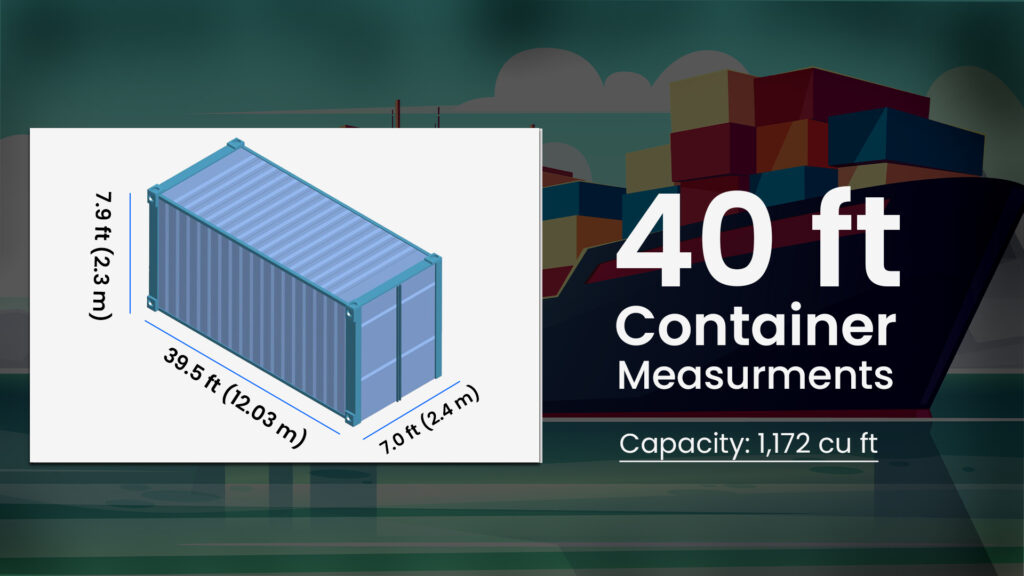
The workhorse of the shipping world, 40ft or 40-foot containers make up about 70% of the global container fleet. Externally, they measure 40ft x 8ft with a maximum gross mass of 30,480kg.
With an internal length of 39.5ft and width of 7.9ft, the 40ft container provides 2,387 cubic feet of cargo capacity. The tare weight is 3,750kg and maximum payload capacity is 27,600kg. The total volume is 67.7 cubic meters.
With double the cargo capacity of a 20-footer, 40ft containers are the go-to for many goods, from machinery to furniture. Their larger size does mean that weight limits are more easily reached, however. 40-footers also require bigger trucks, rail cars, and ship slots.
High Cube Containers
High cube (HQ) containers have the same exterior footprints as standard 20ft and 40ft containers but are taller to allow for extra interior headroom.
The 40ft high cube is overwhelmingly more common than the 20ft size. Externally, a 40ft HQ measures 40ft x 8ft with an interior height of 8ft 10in. This added headroom increases the interior volume to 2,691 cubic feet.
A 20ft HQ has exterior dimensions of 19ft 10in long x 8ft wide x 9ft 6in high. Inside, it measures 19ft 4in long x 7ft 8in wide x 8ft 10in high.
The extra ceiling height of high cube containers makes them well-suited for bulky, odd-shaped cargoes that need more space. It also allows for interior fittings like insulation, lighting, and ventilation while maintaining enough headroom.
With their additional cubic capacity compared to standard dry containers, high cubes enable shippers to fit more cargo or taller items. But their exterior remains compatible with trucks, rail, and ships designed for 20ft and 40ft ISO containers.
Dimensions of Common Specialty Shipping Containers
In addition to dry general cargo containers, you’ll also encounter these common specialty container types:
Refrigerated Containers (Reefers) Dimensions
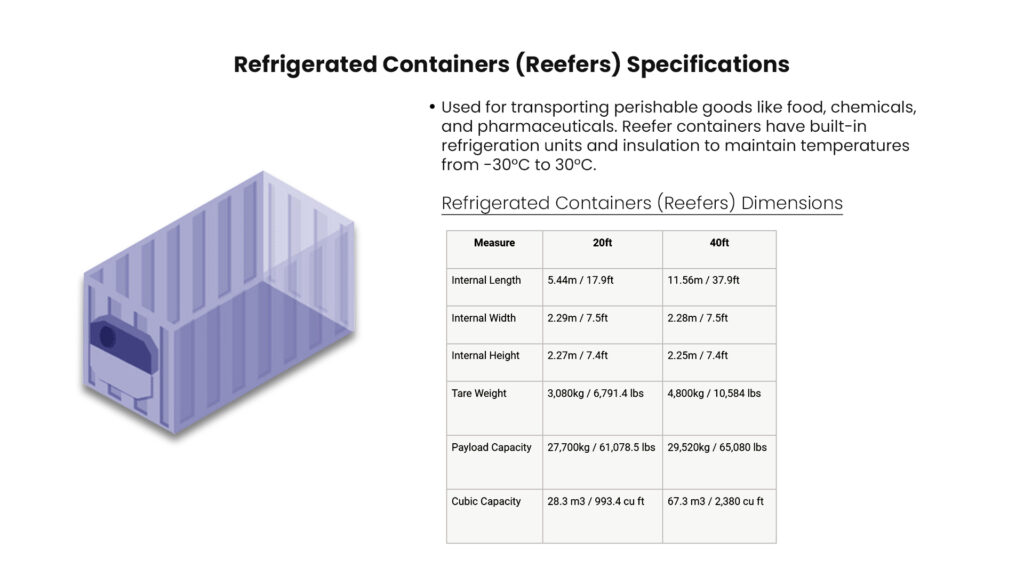
Used for transporting perishable goods like food, chemicals, and pharmaceuticals. Reefer containers have built-in refrigeration units and insulation to maintain temperatures from -30°C to 30°C.
Tank Containers Dimensions
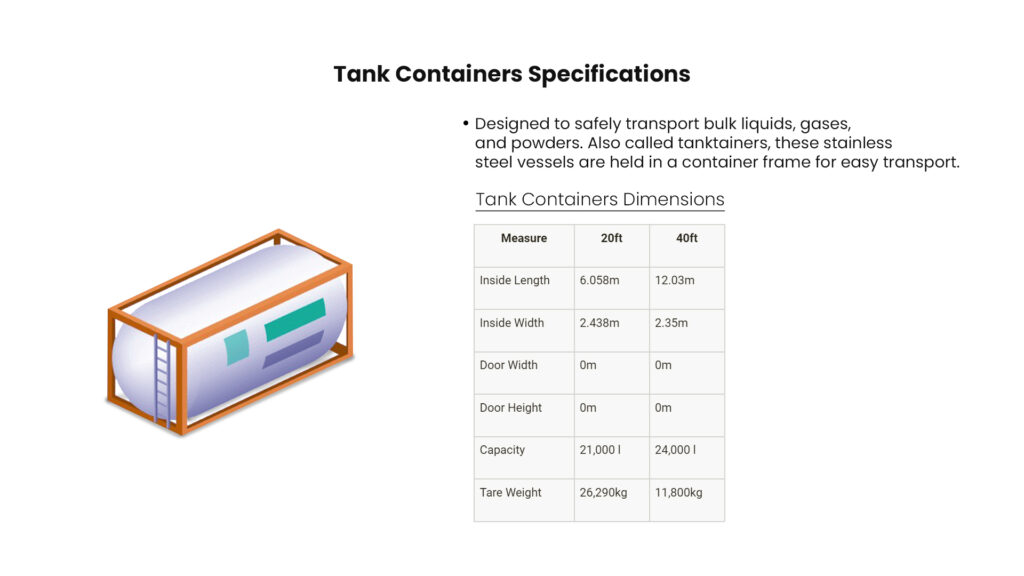
Designed to safely transport bulk liquids, gases, and powders. Also called tanktainers, these stainless steel vessels are held in a container frame for easy transport.
Open Top Containers Dimensions
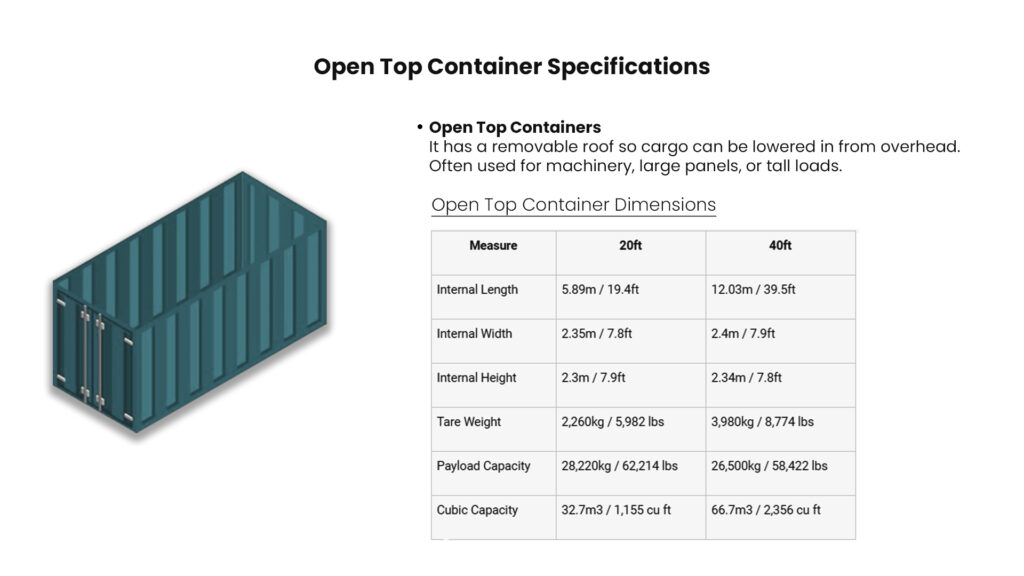
It has a removable roof so cargo can be lowered in from overhead. Often used for machinery, large panels, or tall loads.
Double Door Container Dimensions
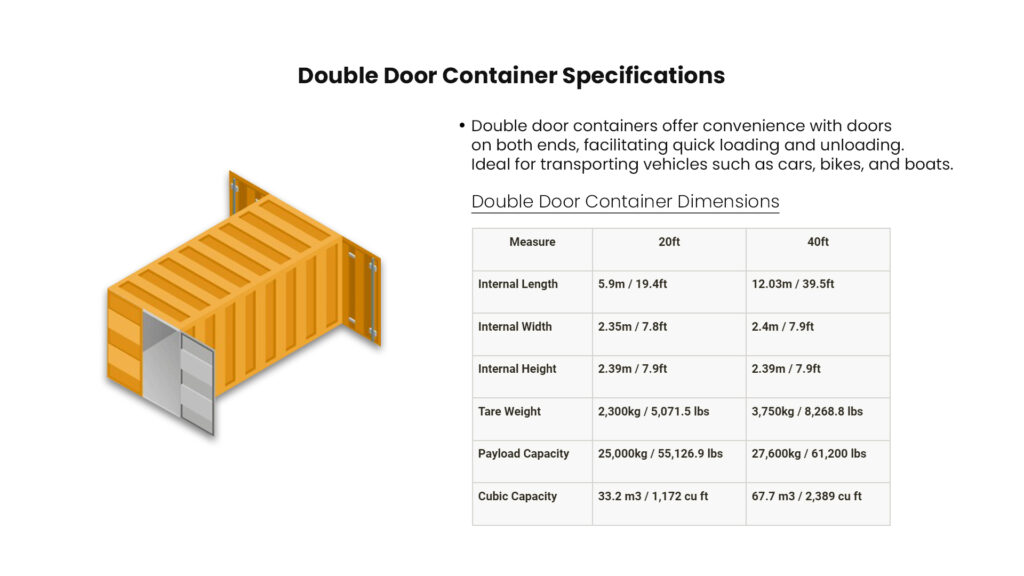
Double door containers offer convenience with doors on both ends, facilitating quick loading and unloading. Ideal for transporting vehicles such as cars, bikes, and boats.
Pallet Wide Container Dimensions
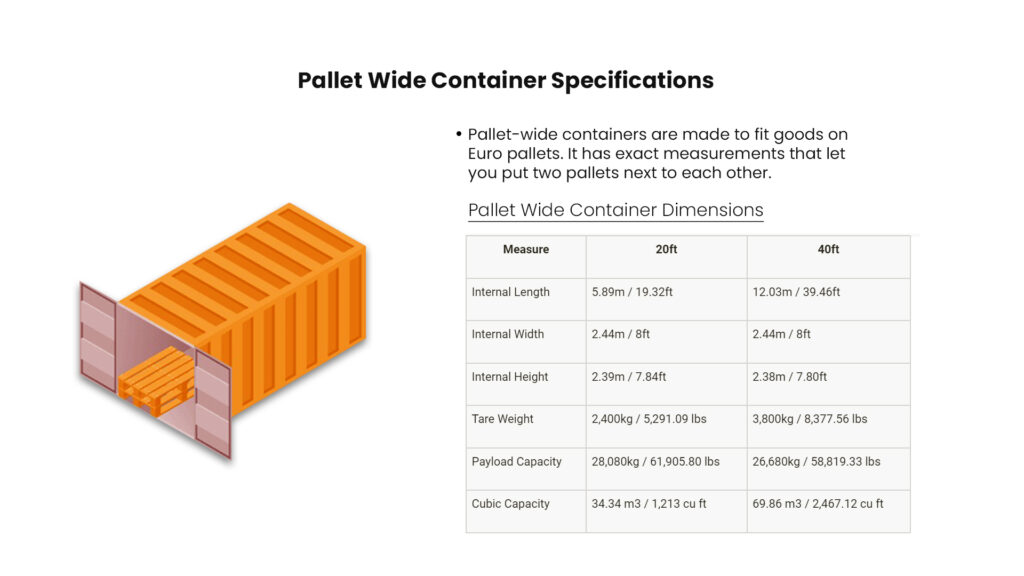
Pallet-wide containers are made to fit goods on Euro pallets. It has exact measurements that let you put two pallets next to each other.
Flat Rack Container Dimensions
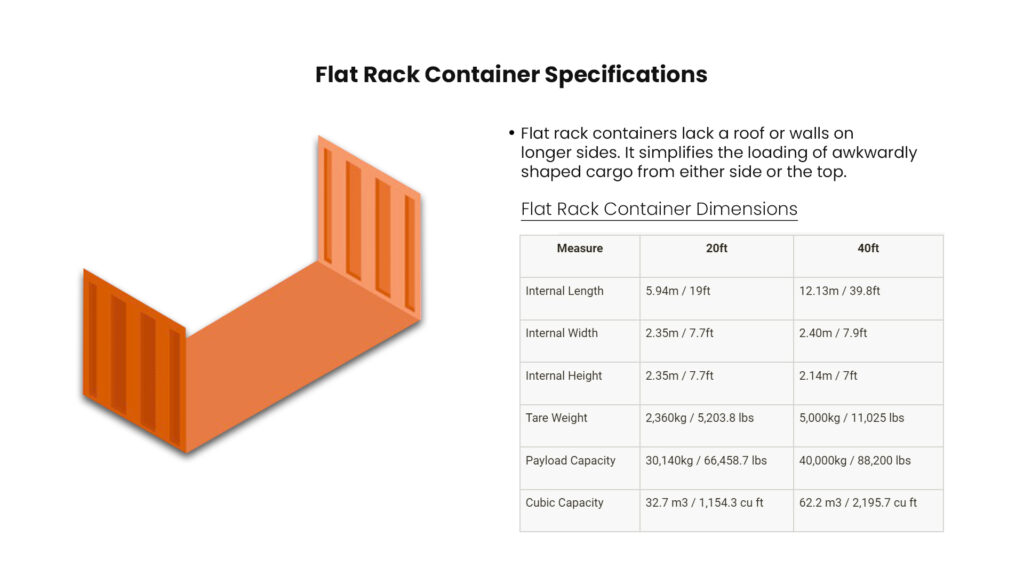
Flat rack containers lack a roof or walls on longer sides. It simplifies the loading of awkwardly shaped cargo from either side or the top.
Hard Top Shipping Container Dimensions
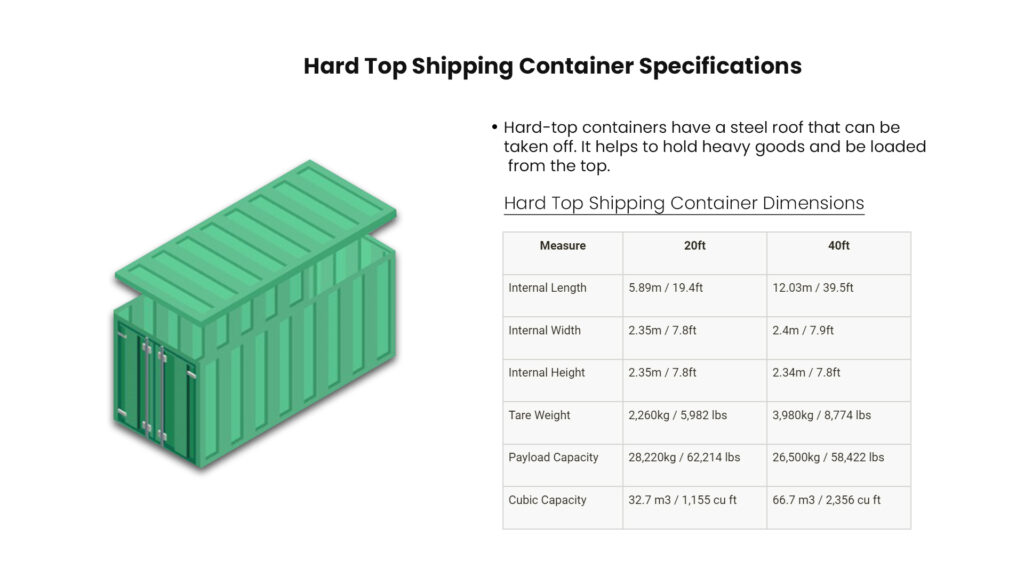
Hard-top containers have a steel roof that can be taken off. It helps to hold heavy goods and be loaded from the top.
Insulated Shipping Container Dimensions
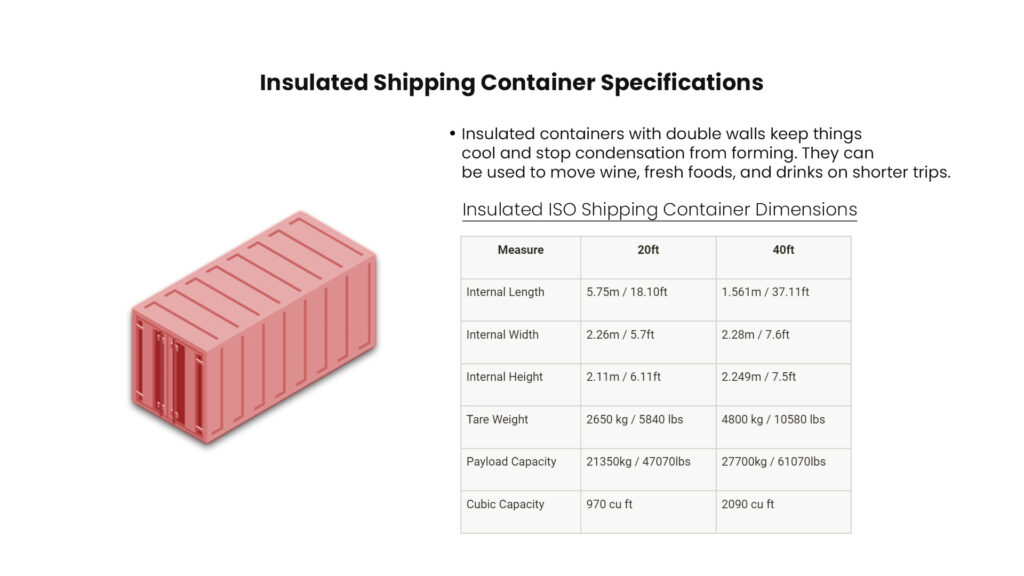
Insulated containers with double walls keep things cool and stop condensation from forming. They can be used to move wine, fresh foods, and drinks on shorter trips.
Advantages of Standardized Shipping Container Dimensions
Why has standardization made such an impact? It comes down to optimization across the entire supply chain:
- Shipping carriers can design container ships, trucks, and rail cars around a limited set of dimensions. This allows them to maximize cargo capacity and loading efficiency.
- Port and rail facilities can layout equipment like cranes and storage areas to precisely fit standard container sizes.
- With fixed dimensions, containers can be stacked securely. Standard corner castings allow twist locks and other mechanisms to keep stacks together.
- Most containers have standardized features like forklift pockets, so they can be easily manipulated by equipment designed for their sizes.
- Containers can switch between truck, rail and ship transportation seamlessly. This enables efficient intermodal transport since cargo does not have to be repacked.
- Uniform container IDs and tracking systems can be applied globally based on the standard dimensions.
- Customs and security agencies can better scan and inspect containers when they fall into a limited range of standard sizes. This facilitates cross-border trade.
How to Select the Perfect Shipping Container
Now that you know about the different types and sizes of standard shipping containers, you can pick the best one for your freight needs. However, let’s cover it in a nutshell:
- The 20-foot barrel is flexible and easy to move for small, light loads.
- The 40ft or 40ft high cube containers have plenty of space for heavy, bulky goods.
- Perishable or temperature controlled goods will require an insulated reefer.
- For liquids and gases, consider tank containers.
- If your loads are too big, you might need a flat rack or open top custom container.
- Refrigerated Shipping is the solution for transporting pharmaceuticals, dairy products, meat and poultry, and floral products.
The Future of Shipping Container Technology
Global trade has grown exponentially over the past 50 years due to international standards and common container sizes. What does this industry have in store for the future?
You can expect to see progress in the size and efficiency of container ships. Eco-friendly designs and hybrid/electric propulsion systems are also getting more attention to help the Earth. Fast-changing tracking technology is making real-time container tracking across supply chains even easier.
But even though revolutionary changes will keep happening, the basic idea of common container sizes is here to stay. The system is just too well-tuned and set in stone. The ISO will keep pushing for safety and efficiency improvements around these established sizes.
Conclusion
Well, time to wrap up! Now that you know the standard shipping container dimensions, you can select the right size for your cargo. A 20-foot container is a flexible option for lighter loads, while 40-foot containers offer more room for bulky goods.
Specialty containers like tanks and refrigerated units also follow dimensional standards, letting them integrate into intermodal transport systems.
Standard container sizes may seem mundane, but they quietly drive the efficiency of global supply chains. Understanding ISO specifications allows you to optimize your shipment while tapping into worldwide containerized trade.
FAQs
Are Containers on Container Ships Typically 20 Feet or 40 Feet in Length?
Most container ships carry either 20-foot or 40-foot containers. In North America, ISO shipping containers are commonly 8 feet wide, 8’6” high, and either 20 or 40 feet long. The 40-foot containers are popular among buyers.
What Are Standard Container Sizes for Shipping?
Shipping containers come in different sizes, but the standard ones are usually 20 or 40 feet long and 8 feet wide. This variety ensures flexibility when transporting goods.
What Is the Difference Between a 20-Foot Container and a 40-Foot Container?
A 20-foot container may hold up to 21.85 tons of cargo with 33.50 m³ of space. In comparison, a 40-foot container accommodates 2.53 m³ of cargo for every ton, limiting the load to 26.76 tons within its 67.70 m³ space. Choose wisely based on your cargo needs.

